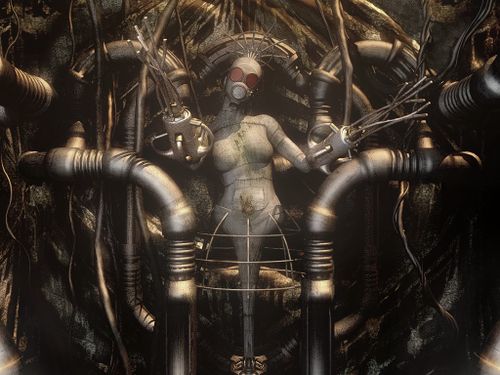TL;DR: A brief and incomplete re-reading of Donna Haraway’s “A Cyborg Manifesto.”[1] |
Reading Donna Haraway’s “A Manifesto for Cyborgs” gets me thinking (again!) about the importance of language. While language has been important since “Aristotle still ruled,” it has taken on an increased significance since the beginning of the move from atoms to bits. The language of western civilizations has been interwoven with the dualities of ideology, since before Plato’s myth of the divided human. This “hierarchical dualism” has always privileged its creator (Man), has been naturalized into mythology, and continues to influence our conceptions of our own bodies and how we place them in the world. Our epistemology and ontology are centered the narratives through which we live and find meaning: mythological narratives like Paradise and the Fall do not bring a wanted universality, but exclude with a façade of inclusion. The myth of Man is an exclusive club — an identity that seeks to control and dominate even in the face of its own demise: the cyborg.

Haraway’s project calls for a re-vision or re-figuration of not only our physical bodies, but our identities as humans.
The signifier “human” carries too much of the baggage of historical inequality to be useful anymore. Instead, the cyborg — while still operating in the humanist myth — penetrates boundaries that “human” cannot encompass. The cyborg can rewrite the body and our conception of it in order to break down exclusive identities and open up new networks through lines of affinity. We have not chosen the cultural myths that control us, but micro-processing technology has the potential, first, to alter these myths in a politicized, networked narrative, and second, recode the revisions onto chimera of the cyborg body in an act of defiant struggle. We are at a crucial time in history, even more now than when Haraway wrote the manifesto in 1985.
We now, more than ever before, conceptualize our bodies in relation to our technologies, and micro-processing technology has led the way. Our bodies are becoming less the sacred shrines and more a gestalt of biomolecular codes that we will soon have the ability to recode into any form we choose. When the word (or gene signifier) becomes the physical object, we have gotten into the inner workings of the machine — its code.
Step aside, Evolution; we’re taking over, for better or for worse.
Yes, it could get worse: everyday we hear scenarios of Big-Brother dystopia, but it seems to me that the technology belongs just as much (if not more) to the individual hacker and cracker as it does to the hegemonic software giant. The giant corporations of the last century will topple under the networked defiance of the cyborgs who continue to break their codes and transgress their boundaries. They say trading music online is illegal. OK. That hasn’t stopped it. Microsoft is developing new DRM software. OK. That will last a week. The technology is becoming decentralized, open to reproduction and replication. The digital bit cannot be controlled the same way as the analog atom. The Big Boys are learning that lesson, but not fast enough to save them.
Haraway’s manifesto is still seminal (excuse the word) to the study of new media. Science fiction is becoming the new reality. The dialectic of last century is tired. We need to grow beyond the human in order to get to the really difficult questions and answers. Why is it that many still insist in rehashing the same old issues, like abortion? This issue is unsolvable using the language of hierarchical dualism. The only way we will move beyond the current controversies is to no longer indulge in their language: what progress have the notions of “good” and “evil” made for us lately? If they were ever useful, that use has been obfuscated under a blanket of familiarity only patriarchs like our presidents and priests use to hide their own sordid affairs. “Good” and “evil” are about as useful as “human.” Shouldn’t we leave them behind?
While we cannot leave our past entirely, we can choose not to let it control what we can become. I think that one of Haraway’s main points here is that we must understand the thing that controls us so that it does not follow us into our digital lives. If the cyborg is an oppositional strategy, first we have to know what it is we oppose. Haraway is not opposed to community; on the contrary, she insists on its importance. Language is the location of meaning: in both the virtual and the real — or perhaps more useful terms would be the bit and the atom. While language is a nebulous, imperfect, and misunderstood arena, it stands central to our struggle for affinity. “Identity” must be understood as a strategic artifact of the past that excludes through naming; affinity supports communication from the margins and includes all voices by allowing us to be alike in our difference. It celebrates what Haraway calls “cyborg imagery” that resists totalizing narratives and allows for the reconstruction of the body free from those narratives by our own volition.
Haraway allows that we cannot escape the domination of language, yet she proposes a domination based on volition and choice, not one based on stories of a totalizing ideology of the One — an autonomous, powerful, God. In this dualistic discourse, the other is preferable: “to be multiple, without clear boundaries, frayed, insubstantial.” While this notion is scary, it is also potentially liberating, but not without its dangers. Is this blasphemy, as Haraway suggests? Is the “human” too sacred a figuration to mess with? What will this do to our humanistic endeavors of morality and ethics? Philosophy? Science? Religion? Art? Even these could be lost, as many other critics predict. What is so important to make us cling to the idea of “human”?
Are we ready to move on?
Note
- ↑ Originally written on January 22, 2003.
